
Fra Angelico was an Italian painter of the Early Renaissance, described by Vasari in his Lives of the Artists as having "a rare and perfect talent". He earned his reputation primarily for the series of frescoes he made for his own friary, San Marco, in Florence.
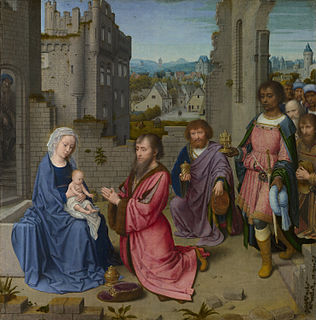
The Adoration of the Magi or Adoration of the Kings is the name traditionally given to the subject in the Nativity of Jesus in art in which the three Magi, represented as kings, especially in the West, having found Jesus by following a star, lay before him gifts of gold, frankincense, and myrrh, and worship him. It is related in the Bible by Matthew 2:11: "On entering the house, they saw the child with Mary his mother; and they knelt down and paid him homage. Then, opening their treasure chests, they offered him gifts of gold, frankincense, and myrrh. And having been warned in a dream not to return to Herod, they left for their own country by another path".

Benozzo Gozzoli was an Italian Renaissance painter from Florence. A pupil of Fra Angelico, Gozzoli is best known for a series of murals in the Magi Chapel of the Palazzo Medici-Riccardi, depicting festive, vibrant processions with fine attention to detail and a pronounced International Gothic influence. The chapel's fresco cycle reveals a new Renaissance interest in nature with its realistic depiction of landscapes and vivid human portraits. Gozzoli is considered one of the most prolific fresco painters of his generation. While he was mainly active in Tuscany, he also worked in Umbria and Rome.

The cultural and artistic events of Italy during the period 1400 to 1499 are collectively referred to as the Quattrocento from the Italian word for the number 400, in turn from millequattrocento, which is Italian for the year 1400. The Quattrocento encompasses the artistic styles of the late Middle Ages, the early Renaissance, and the start of the High Renaissance, generally asserted to begin between 1495 and 1500.

Montefalco is a historic small hill town in Umbria, Italy, with a population of 5,581 in August 2017. It has been settled since pre-Roman times, and retains many of its historic buildings. From 1446 to 1861 it was part of the Papal States. Montefalco DOC is a regulated geographical area for its wine, the reds usually including the highly localized Sagrantino grape variety. The town's museum is in a former church, which has a fresco cycle on the life of St. Francis by the Florentine artist Benozzo Gozzoli (1450–1452).
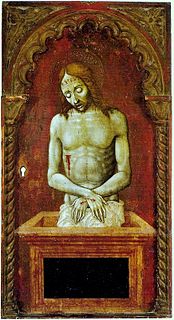
Niccolò di Liberatore, known as L'Alunno (1430–1502) was an Italian painter of the Umbrian school.
The decade of the 1450s in art involved many significant events, especially in sculpture.

The Magi Chapel is a chapel in the Palazzo Medici Riccardi of Florence, Italy. Its walls are almost entirely covered by a famous cycle of frescoes by the Renaissance master Benozzo Gozzoli, painted around 1459 for the Medici family, the effective rulers of Florence.
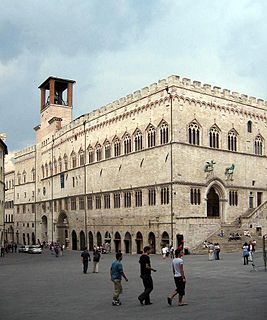
The Galleria Nazionale dell'Umbria the Italian national paintings collection of Umbria, housed in the Palazzo dei Priori, Perugia, in central Italy. Located on the upper floors of the Palazzo dei Priori, the exhibition spaces occupy two floors and the collection comprises the greatest representation of the Umbrian School of painting, ranging from the 13th to the 19th century, strongest in the fourteenth through sixteenth centuries. The collection is presented in 40 exhibition rooms in the Palazzo. On the second floor of the Gallery, there is an exhibition space for temporary collections, changed several times a year.

Bartolomeo Caporali was an Italian painter and miniaturist in Perugia, Umbria during the early Renaissance period. His style was influenced by Umbrian artists Gozzoli and Boccati, two of his first mentors, and continued to evolve as younger Umbrian artists came onto the scene, such as Fiorenzo di Lorenzo, Perugino and Pinturicchio. Although primarily a painter, he is also known for executing missals, restoration work, gilding, armorials, banners and celebratory decorations, which speaks to his decorative, detail-oriented artistic style. His most famous works include Madonna and Saints (1487) for the church of Santa Maria Maddalena at Castiglione del Lago, The Virgin and Child Between Two Praying Angels, and his Adoration of the Shepherds.

Bartolomeo di Giovannidi Domenico was an Italian Renaissance painter active in Florence. His works were first identified by the art historian Bernard Berenson, who did not know the painter's real name so called him the "Alunno di Domenico". This name was based on Berenson's observation that the painter executed the predella of Ghirlandaio's Adoration of the Magi (1488) in the Ospedale degli Innocenti, the foundling hospital in Florence. Archival research later yielded the painter's real name as Bartolomeo di Giovanni. Bartolomeo also collaborated with Sandro Botticelli.

Pier Francesco Fiorentino was a 15th-century painter active in San Gimignano for much of his mature life, depicting religious-themed subjects.

The Palazzo Comunale, also known as the Palazzo del Popolo of San Gimignano has been the seat of the civic authority in the comune since the 13th century. It is located on the Piazza del Duomo close to the Collegiate Church of the Assumption of the Blessed Virgin Mary. The building and Collegiate Church are at the heart of the medieval town, and are part of the UNESCO World Heritage Site of the "Historic Centre of San Gimignano".
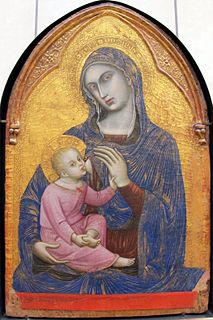
The Nursing Madonna, Virgo Lactans, or Madonna Lactans, is an iconography of the Madonna and Child in which the Virgin Mary is shown breastfeeding the infant Jesus. In Italian it is called the Madonna del Latte. It was a common type in painting until the change in atmosphere after the Council of Trent, in which it was rather discouraged by the church, at least in public contexts, on grounds of propriety.

The Crossing of the Red Sea is a fresco executed in 1481–1482 and located in the Sistine Chapel, Vatican City. Of uncertain attribution, it has been assigned to Cosimo Rosselli.
The detachment of wall paintings involves the removal of a wall painting from the structure of which it formed part. While detachment was once a common practice, the preservation of art in situ is now preferred, and detachment is now largely restricted to cases where the only alternative is total loss. According to the International Council on Monuments and Sites (ICOMOS):
"Detachment and transfer are dangerous, drastic and irreversible operations that severely affect the physical composition, material structure and aesthetic characteristics of wall paintings. These operations are, therefore, only justifiable in extreme cases when all options of in situ treatment are not viable. Should such situations occur, decisions involving detachment and transfer should always be taken by a team of professionals, rather than by the individual who is carrying out the conservation work. Detached paintings should be replaced in their original location whenever possible. Special measures should be taken for the protection and maintenance of detached paintings, and for the prevention of their theft and dispersion. The application of a covering layer concealing an existing decoration, carried out with the intention of preventing damage or destruction by exposure to an inhospitable environment, should be executed with materials compatible with the wall painting, and in a way that will permit future uncovering. "
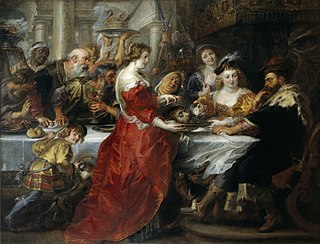
The Feast of Herod refers to the episode in the Gospels following the Beheading of St. John the Baptist, when Salome presents his head to her parents. The account in the Book of Mark describes Herod holding a banquet on his birthday for his high officials and military commanders, and leading men of Galilee. At this banquet, Herod's daughter dances before Herod, who is pleased and offers her anything she asks for in return. The girl asks her mother what she should request, and she is told to demand the head of John the Baptist. Reluctantly, Herod orders the beheading of John, and John's head is delivered to her, at her request, "on a platter."(Mark 6:17–29)

Alesso di Benozzo, also known as Alesso Gozzoli, was an Italian Renaissance painter. He was born in Pisa in 1473 and began his career as an assistant to his father, the famous Florentine Benozzo Gozzoli. In 1492 he signed the Tabernacle of the Visitation together with his father, who headed the project, and brother, Francesco. Because of their similar styles, the individual contributions of each painter are not easy to distinguish, but the art historian Anna Padoa Rizzo has proposed that the more refined and elegant figures are by Alesso, whom documents suggest was Gozzoli's most esteemed son, and that the coarser passages are by Francesco, apparently of lesser renown. Padoa Rizzo in turn identified Alesso as the anonymous artist previously known by two names: the "Maestro Esiguo," invented by Roberto Longhi in reference to the painter's skinny and exiguous figures, and the "Alunno di Benozzo," literally the "student of Benozzo," a nickname invented by Bernard Berenson. His works were also once wrongly assigned to Amedeo Laini, called Amedeo da Pistoia.
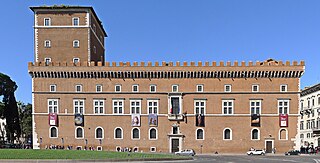
The Museo Nazionale del Palazzo di Venezia is a state museum in Rome (Italy), housed in the palace of the same name together with the important Library of Archaeology and Art History.

The painting of the Purification of the Virgin is a High-Renaissance-style tempera panel piece from an altarpiece painted by Benozzo Gozzoli and once owned by the Compagnia di Santa Maria della Purificazione e di San Zanobi of Florence, Italy. The painting is on display in the Philadelphia Museum of Art in Philadelphia, Pennsylvania, United States of America.


















